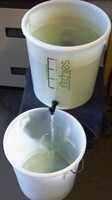All Grain Brewing
All Grain Brewing.
After successfully brewing with kits, many brewers feel the urge/need to move on to all grain brewing. This is brewing using the same techniques that commercial breweries use, but on a smaller scale and with less complicated equipment and procedures. It allows the brewer to either make a beer that is specifically matched to their own personal tastes, or that mimics a well known commercial brew.
There are several books available, such as Dave Line’s “Brewing Beers like those you Buy” and Graham Wheeler’s “Brew your own British Real Ale”, that provide recipes based on well known beers such as Courage Directors, Ruddles County, Timothy Taylor Landlord and Guinness. Many other recipes are readily available via the numerous brewing forums, such as the one at Jim’s Beer Kit, where you can also find instructions on how to make most of the equipment being used, if you don't wish to buy the commercially available versions.
In essence, brewing from grain requires the following steps:
- The brewing water is treated to remove any chlorine and excessive hardness and match the water used in the beer style being brewed.
- The grain is mixed into hot water and left for around 90 minutes at approx 65°C to convert the stored carbohydrates into usable sugars. This is known as Mashing.
- The sugars are washed out of the grain mixture using water at approx 80°C. This is known as Sparging.
- The resulting liquid, the Wort, is collected and brought to the boil.
- Hops are added and boiled for 90 minutes to extract the bitterness.
- The liquid is rapidly cooled and run off into your fermentation vessel ready for the yeast to be added.
- Fermentation, clearing, storage and conditioning then take place as per normal.
In practice, it works like this:
1) In Colchester, we have fairly hard water which often contains high levels of chlorine, so I start by running 25ltrs of tap water into my boiler and adding a level teaspoon of Gypsum, before bringing it to the boil and allowing it to boil for around 30 minutes to drive off the chlorine and help to remove the limescale. If you live in a soft water area, you probably won't need to do this, but the layer of "scum on the water surface in the 4th picture below shows you why I have to do it....
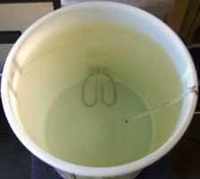 | 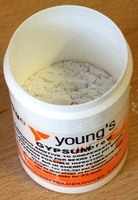 | 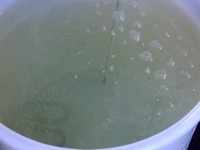 | 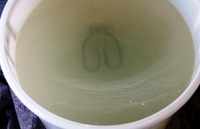 | |
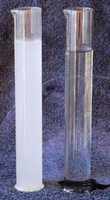 | The water is left to cool overnight water to encourage the dissolved limescale (Calcium Carbonate) to drop out of solution. These two trial jars contain the treated water on the right and the sediment filled dregs on the left... The following morning, the cleared water is run off, leaving the sediment behind. As I am brewing a bitter in this process, a teaspoon of Epsom Salts (Magnesium Sulphate) is now added to the brewing water, or liquor as brewers call it, to increase the pH level to that needed to ensure an efficient mash. The boiler is then rinsed to remove the sediment. If you have access to a water analysis from your local water board, you can treat the water using AMS/CRS and DWB/DLS which avoids the time, effort and cost of boiling the water. | 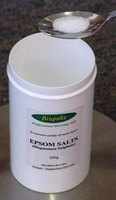 |
2) 15ltrs of the liquor is now heated to 80°C and, whilst this is happening, I weigh out the grain mix as per the recipe. The bulk of the grain mix is made up of crushed pale malt which provides the fermentable sugars which are extracted during the mashing process. Most beers contain varying amounts of coloured malts which are used to add colour and flavour. In this recipe, which aims to replicate Timothy Taylor Landlord Ale, a small amount of Crushed Black Malt is added to the mix to provide colour without unduly affecting the flavour. The grain is then thoroughly mixed to give an even distribution of the black malt and a consistent colour.
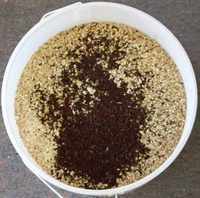 | 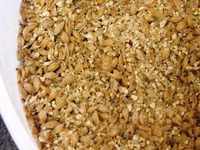 | 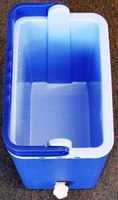 |  | 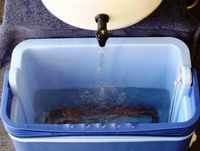 |
The grain needs to be mixed into hot water in a Mash Tun at a rate of around 2-2½ltrs per kilo of grain being used. In this recipe there are around 4½kgs of grain, so I have used 11ltrs of hot water for the mash. A mash tun is simply a container in which the grain can sit at a steady temperature for about 90 minutes whilst the enzymes that are present in the grain convert the starch (carbohydrates) into fermentable sugar. Mine is a converted picnic box in which I have increased the insulation and drilled a hole to accept a drum tap. I also have a home made strainer which is inserted into the back of the tap and acts as a syphoning device to draw off the wort from below the level of the tap. After using this a couple of times, I swapped to using a mashing bag to strain off my grain as it makes emptying the mash tun a great deal easier, but the strainer is shown here in situ to demonstrate how it can be constructed and used.
The hot water (80°C) sits for a few minutes to preheat the tun until the temperature has dropped to around 72°C, at which point, I start to add the grain mixture, stirring constantly to ensure that it is thoroughly mixed to the consistency of thick porridge and avoid any dry clumps. When all the grain is mixed in, the temperature should have stabilised near to 65°C and the lid can be placed tightly on the box to maintain the temperature.
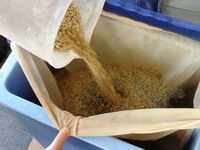 | 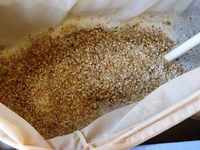 |  | 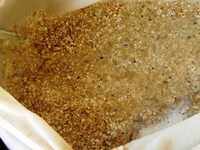 | 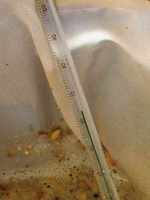 |
3) After about an hour the remaining treated water is returned to the cleaned boiler and is topped up using value bottled water so that I have approx 23ltrs available for the next stage. Over the next 30 minutes or so, this water is heated to 80°C as this is the ideal temperature to ensure that the sugar creating enzymes are killed off and the sugars are most easily washed out of the grain mix. This process, known as sparging, entails nothing more than gently pouring the hot water over the grains and allowing it to seep though the mixture, pulling the sugars with it. There are many ways of achieving this, such as using a jug to pour a small amount of hot water at a time over the grain or using a slowly rotating arm that works like a sprinkler system, but I use nothing more complicated that a piece of ½" syphon tubing connected to the boiler tap. I have a tap fitted 2/3 along the length of the syphon tube that allows me to vary the flow rate into my mash tun, which I try to match with the outflow from the lower tap so that there is a consistent flow rate. The first few pints that are collected are usually quite cloudy as they will often contain any loose "flour" particles that will have dropped out of the grain porridge during the 90 minute mash period. These are returned to the top of the mash tun and allowed to filter back through the grain bed.
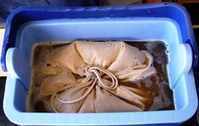 | 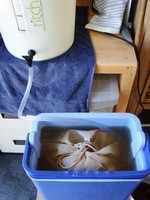 | 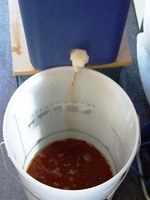 | 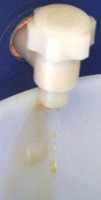 |  |
4) I continue to collect the runnings until they are almost clear and my boiler is empty. The extraction of the sugars seems to work most efficiently if the run-off is carried out slowly. This usually takes me around 25-30 minutes to achieve. By the time I have emptied the boiler, I have usually collected around 20-22 litres of wort which can now be added to the boiler. The last 10-12 litres of liquid will be left in the mash tun to soak through the grain and the runnings are used to top up the boiler during the 90 minute boil. In the first picture below, you can see my Hop Strainer fitted to the boiler. It is usually easier to fit this BEFORE you start to add or boil the wort.
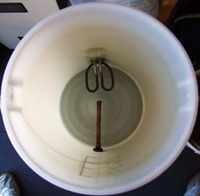 | 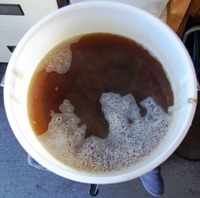 | 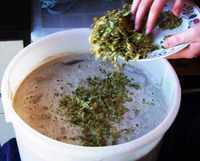 | 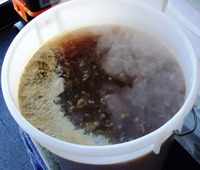 | 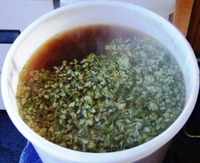 |
5) As soon as the wort reaches a full rolling boil, which usually happens at a temperature of around 105°C, the first batch of hops are added. Hops need to be boiled for around 60-90 minutes to extract the full bittering compounds. Each hop variety has different flavour and bittering properties and the amount of bitterness you can obtain from it is determined by its "Alpha Acid" level. The higher this is, the less of the hop you need to achieve the desired bitterness level. (In Europe, this is usually expressed as the EBU of the beer). Unfortunately, a long boil to extract the bitterness also destroys many of the flavour and aroma properties of the hop, so it is common practice to add a second batch of hops about 15 minutes before the end of the boil to replace these elements in the finished brew. These are known as the "Late Boil Hops". An odd substance called "Irish Moss", which is actually a form of dried seaweed, is added at the same time because it helps to produce an effect known as the "Hot Break". This is where the proteins that would otherwise lead to a cloudy beer are coagulated and start to clump together.
 | 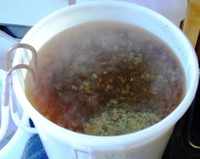 |  | 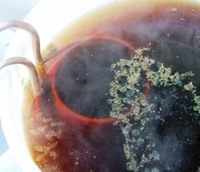 | 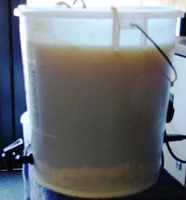 |
6) In order to prevent infection of the wort and to cause an effect known as the "Cold Break", during which all the material that has clumped together during the "Hot Break" falls out of suspension, it is essential that it is cooled as quickly as possible. I use a simple immersion chiller that is added to the boiler at the same time as the Irish Moss. This acts as a simple heat exchanger and is normally connected directly to a cold water tap, but, as I don't have conveniently accessible running water in my unit, I use a 60ltr bucket filled with cold water as my cooling reservoir and feed the cooler via gravity.
When the boil has finished, the first 10ltrs of cooling water that come through the chiller are around 70°C. If you collect this in one bucket, then collect the next 20-25ltrs (which will average out at about 40°C) in a separate bucket, and finally collect the last 10-15ltrs in the first bucket, the temperature of all this cooling water will average out at about 40°C and you will have plenty of warm water to use for washing all your equipment.
I adjust the flow rate of the cooling water to around 1½-2ltrs per minute, so it normally takes around 30-40 minutes to cool my wort to 20-25°, depending on the feed water temperature. This can vary from 17-20°C if I'm brewing in the summer to as low as 10°C in winter. The lower the feed water temperature, the faster the wort will be cooled. When the correct temperature has been reached (20-24°C), the hops and proteins thrown out of suspension during the "hot" and "cold" break points will have settled on the bottom of the boiler. This is known as the "Trub".
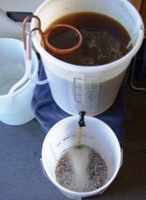 | 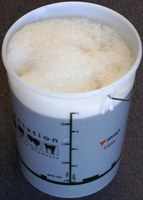 |  | 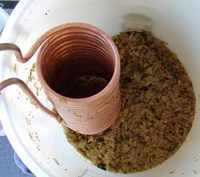 |
7) The tap on the boiler can now be opened and the wort run off into a cleaned and rinsed fermentation vessel. The churning that happens during this run-off will cause lots of air to be absorbed into the wort, which aids the yeast in its reproduction stage. When the fermenter is full, the gravity is checked, in this case it was 1042 which was exactly what I was aiming for, and yeast is added and fermentation, racking, bottling/barrelling and conditioning continue as normal. Some brewers use specific named liquid yeast varieties to try to further match the brew being made, but I tend to use a general all purpose ale yeast such as Safale 04 or one of the Mangrove Jack range of yeasts as I always have both of these in stock in the shop.
If you would like a copy of these instructions for your own use you can download a PDF copy.

